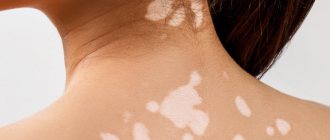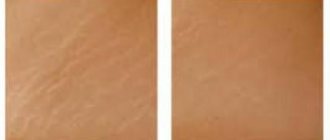A pleasant and uniform tan that does not evoke associations with charcoal shades, in most cases looks fresh and attractive. Golden-bronze tints on the skin transform the appearance, add notes of freshness and youth to it and, moreover, mask minor defects in the microrelief of the dermis. But achieving the ideal shade is not as easy as it seems at first glance: even meticulous skin care before and after tanning in a solarium and in the sun does not guarantee a 100% result - in some cases it is unrealistic to overcome genetics and body characteristics.
Sunbathe with caution
The appearance of white spots on the skin after sun exposure is one of the fairly common problems faced by lovers of sunbathing and ultraviolet cabins. What is the cause of such a defect, is it dangerous to health and what can be done to restore aesthetic perfection to the skin tone? Advice from experienced dermatologists and beauty experts will help you understand the features of such an anomaly.
What are white spots on the skin?
Unfortunately, not every person is naturally given the opportunity to easily and quickly develop a pronounced and lasting tan: for some, this result is the result of long-term and scrupulous work on their own appearance, while others, no matter how hard they try, are simply not able to acquire chocolate tones naturally . If darker-skinned Mediterraneans and Central Europeans tan in just a couple of sessions in a solarium, then fair-skinned owners of Scandinavian and Nordic appearance have no such luxury - they have to try hard to get the desired tones, and the result does not always justify the efforts made: in some cases, excessive persistence ends the appearance of white spots on the skin.
Redheads should be especially careful!
Light areas that appear on the skin after tanning for no apparent reason are physiologically a defect in the production of tanning pigment - melanin , which colors the skin in bronze tones. Most often, they do not manifest themselves in any way, do not cause itching or other discomfort. This disease is typical for those with ultraviolet-sensitive skin - children under 12-13 years of age, until the immune defense is fully formed, women during the period of hormonal changes and after 40 years, as well as red-haired and pale-skinned Scandinavians, whose dermis cannot withstand intense UV radiation . However, this does not mean that others are immune from the appearance of white spots after tanning - such a defect can occur against the background of health problems, or can be caused by improper or too intense tanning.
Common causes of light spots after sunbathing
White spots on the skin cannot be caused by sunbathing - rather, it is an incorrect reaction to ultraviolet radiation, which manifests itself due to various factors. The most common causes of this defect include:
- Low melanin levels. If the amount of pigment in the dermal cells is small, and the synthesis of new molecules works at half capacity, it is not surprising that light spots remain on the skin after sun exposure.
- Increased sweating. Excess sebum and sweat reflect some of the sun's rays, making the tan unstable and uneven.
- Vitiligo. If some of the dermal cells are not able to produce pigment along with the rest, it is not surprising that light spots will appear on the skin after tanning. Typically, such dysfunction appears after sunburn and various mechanical injuries.
These white spots...
- Pityriasis versicolor. The fungus that has grown on the surface of the skin blocks some of the UV rays, so the cells react differently to tanning sessions. As a result, the shade turns out uneven, with light areas of varying sizes and, moreover, washes off very quickly.
- Guttate hypomelanosis. Another disease that affects the reaction of the dermis to ultraviolet radiation is of a genetic nature.
- Reaction to pharmaceuticals. Some pharmacological substances affect the skin's ability to synthesize melanin, resulting in a dull and patchy tan. One example of such drugs is birth control pills, which change the level of hormones in the body and can affect the protective functions of the dermis.
For advice, see a doctor
However, you should not immediately panic if you notice unsightly white formations after tanning - they can be caused not only by serious dermatological diseases, but also by a banal lack of care and a pathological craving for extremely dark shades. Only a qualified doctor can determine the specific cause and prescribe adequate treatment, so it is worth making an appointment and undergoing a thorough examination - this way you will know what is happening to the body and what condition your skin is in.
Sun marks - hyperpigmentation
We have figured out the underlying causes of hyperpigmentation. But the main provocateur for the appearance of such spots is sunlight. They cause increased production by the body of cells that are responsible for skin coloring, injecting melanin pigment into it. In fact, its main task is to protect the skin from harmful UV rays. But when there is an excess of it, its protective functions are reduced. Therefore, cosmetologists never tire of repeating how important it is to use sunscreen, especially for fair-skinned and red-haired people. At the same time, it is better for Russians to buy creams or sprays with an SPF of at least 30. But many rely on chance and neglect them and like to sunbathe until black.
Any hyperpigmentation provokes early skin aging and the appearance of deep wrinkles. But this is not even the worst thing - in some cases, pigment spots can degenerate into melanoma.
How to increase your chances of an even tan? Useful tips
Treatment of dermatological defects directly depends on the reasons that caused them. But what to do if everything is in order with your health, a medical examination did not reveal any abnormalities, and the flawless shade does not want to “lay down” on the skin? Try changing your approach to daily care and tanning sessions, and perhaps the color will be natural and uniform, and there will be no trace of white spots left:
- Main quality! Avoid cheap and untested skincare products. At best, it will be useless, at worst, it can harm the tanning dermis. It is better to buy 1-2, but high-quality creams or lotions that can provide the dermal cells with everything they need.
- Monitor your vitamin balance. Vitamin and mineral complexes included in cosmetics can intensively nourish the dermis, as a result of which it tans better and more actively. Ideally, the chosen cream will contain vitamins A and E, natural oils and plant extracts for deep nutrition of skin cells (the effect of vitamins on tanning).
The main thing for skin is care
- Maintain drinking regime. Dehydration affects not only the condition of internal organs, but also the sensitivity of the skin. Try to drink more fluids before and after sun exposure, and also avoid overly salty and smoked foods that retain water in the body - this way you can maintain a normal water-salt balance.
- Cleanse your skin in a timely manner. Dead skin flakes, clogged pores, sweat, sebum deposits and other impurities unevenly reduce the skin's sensitivity to ultraviolet light, which can lead to blemishes. Therefore, when going to the beach, take sanitary napkins with you to cleanse your skin, and also regularly use mild peels and detergents designed for delicate cleansing - this will help you prepare for the session and make your tan more durable.
- Maintain good hygiene. When visiting a solarium, make sure that the administrator treats the booth with a disinfectant after each client. Be sure to use disposable mats, paper footprints to protect your feet, and your own sunglasses - this way you will protect yourself from infectious skin diseases.
Reduce your tanning sessions
And most importantly, don’t overdo it! If, despite all efforts, the tan does not become uniform and deep, and the number and size of white spots increases, you should give up long sunbathing and sessions in the solarium - alas, in this case you will not be able to overcome the peculiarities of your skin.
Causes of spots after sunbathing
Often, after extensive sunbathing, many people notice white spots on their body. Reasons why this happens:
Find the answer
Are you having any problem? Enter “Symptom” or “Name of the disease” into the form, press Enter and you will find out all the treatment for this problem or disease.
- Fungus and infection. Abnormal pigmentation in many cases is associated with the presence of fungal infections in the body. You may not realize that he is a carrier of lichen; no special symptoms are observed. The first alarm bells appear when tanned skin begins to differ in color from the affected areas. You cannot treat this disease on your own; it is better to trust a dermatologist, he can find out the nature of the problem and suggest actions to eliminate it. Stress and medication help spread lichen.
- Medicines. Some types of drugs can seriously increase the skin's sensitivity to light, which damages the natural level of pigmentation. The skin will be vulnerable to ultraviolet rays, and white spots will form after tanning. It is worth consulting with your doctor before taking medications.
- Vitiligo. A disease in which white spots may appear after sunbathing is vitiligo. The disease has recently become widespread. The disease is that some areas of the skin, the hands, are completely devoid of melanin, and during tanning sessions, spots may appear. The occurrence of vitiligo is associated with stress and disruption of the nervous system. By accurately determining the causes of the disease, magical treatment becomes possible.
Self-tanning - a safe alternative to sun tanning, or How to defeat nature
If you dream of a golden-bronze tone, but the white spots on your skin don’t want to go away, don’t despair: such a problem is not a death sentence! The possibilities of modern cosmetology allow you to get a gorgeous tan without leaving your home.
A properly selected self-tanning cosmetic product will quickly cover the skin with a uniform chocolate shade, visually indistinguishable from natural, and safe formulas will not cause the slightest harm to sensitive areas of the dermis.
Modern self-tanners give the perfect tone
Forget about reddish-yellow stains on the skin and unwashable stains on clothes - modern self-tanners have important advantages that make it as easy as possible to obtain the desired shades:
- 100% safety. Among the range of professional self-tanners there are delicate products designed for hypersensitive skin, so you don’t have to worry about the unpleasant consequences of application.
- Minimum effort. If you are not one of the lucky ones whom nature has awarded with dark skin of 3-4 phototypes, you know firsthand how difficult it is to achieve a noticeable result. Powerful instant tanning formulas can save you the hassle of covering your skin with long-lasting, sun-kissed tones in just a couple of hours. And if you pre-prepare the skin by triggering the receptors with a 2-3-minute session in the solarium a day before application, the effect will be simply stunning!
- Economical. At first glance, it may seem that maintaining an artificial tan is several times more expensive than visiting a solarium. In fact, everything is completely different: the cost of a bottle, which can be used at home, includes at least 6-8 applications, each of which lasts on average 1 week. That is, 1 jar of self-tanning is enough for two whole months! To achieve the same results after a solarium, you will have to spend no less money, and without constant support, the tone will very quickly lighten and wash off. And if you add to this the costs of transportation, cosmetics and disposable protective accessories for each ultraviolet session, the difference will be very noticeable, and not in favor of the solarium!
Self tanners really work
You should not experiment with the health of your own skin, trying to achieve the desired shade - modern self-tanners can make this much easier, faster and safer. In addition, you don’t have to worry about overdrying, sunburn and photoaging - a well-chosen composition not only recreates the desired tone, but also takes care of the condition of your dermis, nourishing and moisturizing it. Do not deny yourself the pleasure of showing off the attractive golden-bronze tints without risking ruining your skin!
Breaking the rules while tanning
Often, after sunbathing, such spots appear on the inside of the thigh, on the neck and on the sides, that is, on the side of the person’s torso. And this happens when the position during tanning is chosen incorrectly and ultraviolet light simply cannot penetrate these places.
Sometimes the problem is discovered because the sunscreen was not applied evenly across the body, or if it was only applied to certain areas of the body, such as the shoulders and nose. Compared to other areas where the tan remains, the skin in these areas is paler.
KK Adapt. 5 paragraph
Other disturbances in the body
Insufficient production of melanin and, as a consequence, remaining light areas of the epidermis after tanning are possible for reasons such as:
- kidney and liver diseases;
- hormonal imbalances;
- thyroid dysfunction;
- the presence of infections in the body;
- stress and depression.
If the skin is pale, the spots may not be particularly noticeable, but they are visible immediately after a person tans in the sun or in a solarium. The origin of this defect due to an incorrectly chosen position is one thing, but if the spots appeared for another reason, which cannot be established independently, then you should visit a dermatologist.










